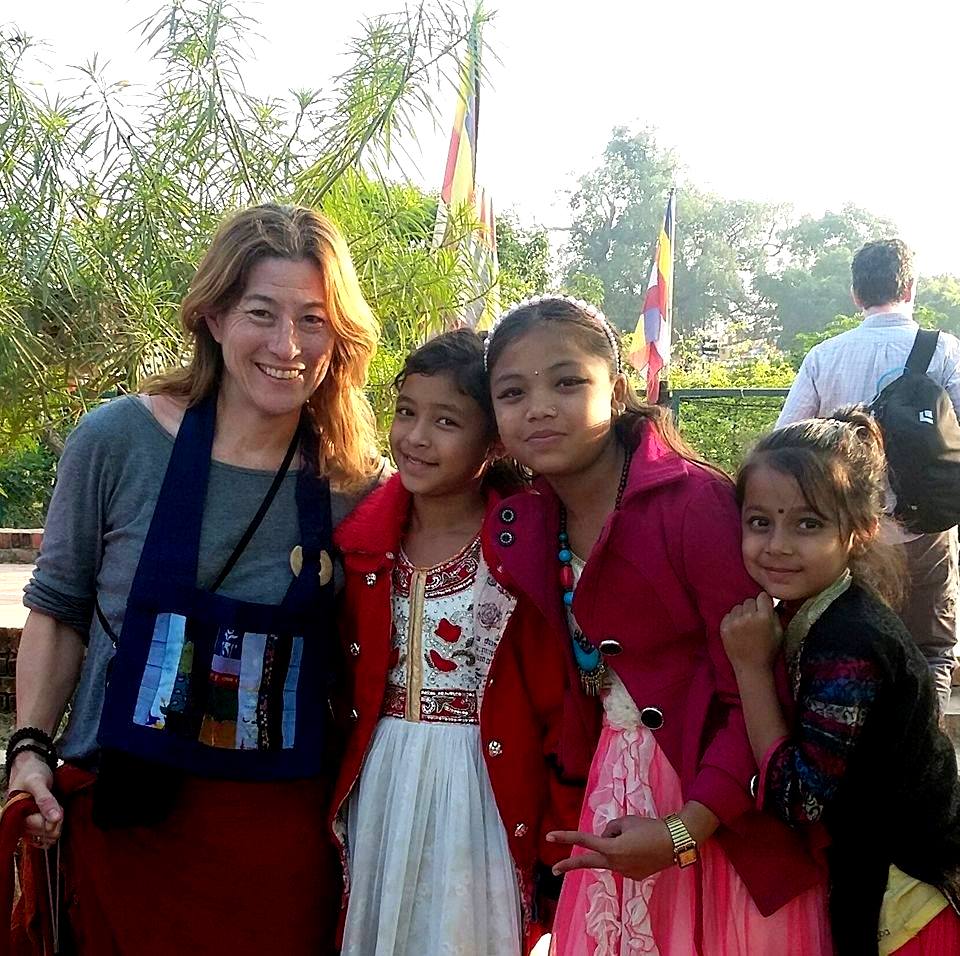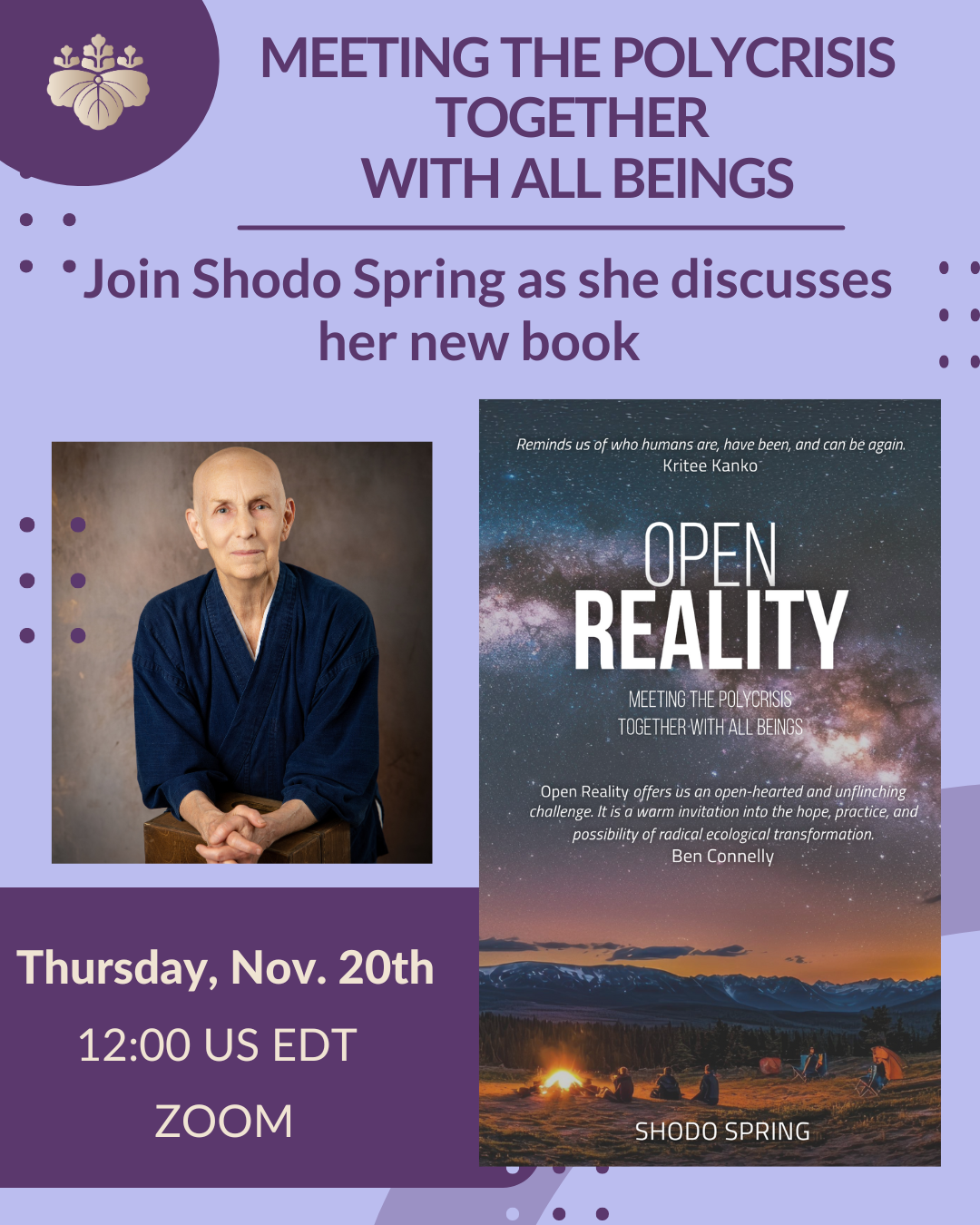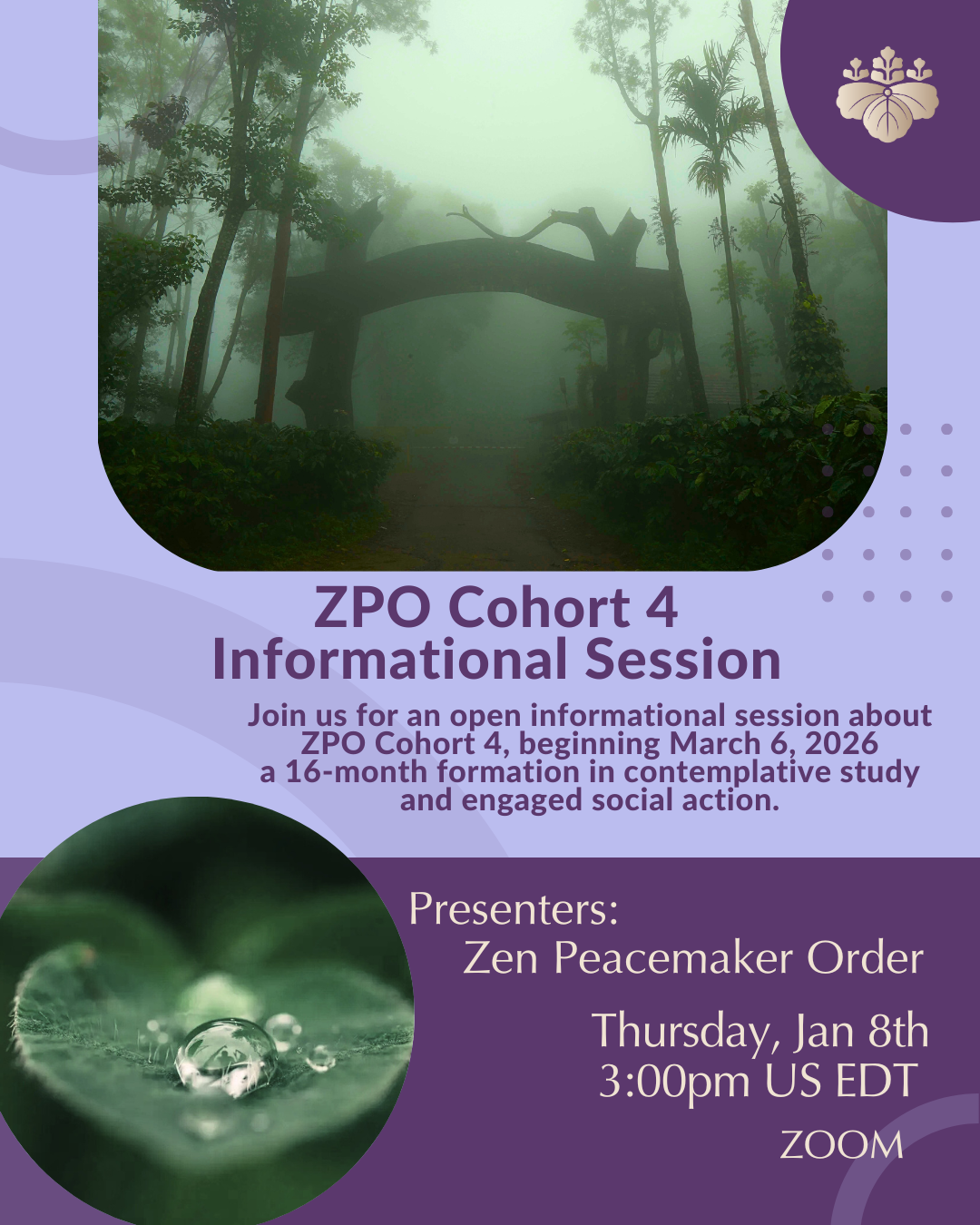Irene Ji Un Edelmann wearing her rakusu on her pilgrimage to Lumbini, Nepal, the birthplace of the Buddha.
YONKERS, NEW YORK STATE, USA. Lay practitioners of Zen Buddhist lineages who take refuge in the Buddhist precepts and vows prepare and wear a rakusu – a cloth garment around their neck – representing the monastic robe, also known as kesa. In the days of the Buddha, it is said that certain materials called Pamsula were taboo for use by society. This included materials used for shrouds covering the dead, those gnawed by rats, or menstrual rags. These were collected to create the monks’ robes. The late co-founder of the Zen Peacemaker Order, Roshi Sandra Jishu Holmes, first ideated the Zen Peacemaker Rakusu that is made up of pieces of discarded cloth from origins meaningful to their wearer’s life and practice. This series of posts named ‘Rags to Rakusus,’ showcases the personal stories of Zen Peacemakers’ rakusus around the world.
Rags to Rakusus: Irene
Written by Jessie Zelisko, Zen Peacemakers Staff
Irene discovered Zen while she was in Kyoto at Ryoan-ji Temple. Irene’s mother is Japanese, and in her late twenties, Irene embarked on a journey to discover more about her heritage, family history, and culture. While visiting the famous rock gardens at Ryoan-ji Temple, Irene encountered a Zen monk. “He didn’t say a word to me, he just silently came up and handed me a brochure in English because he knew I didn’t speak Japanese. And just his manner…something struck me; his being was incredibly astounding.” This encounter planted the seeds that would later blossom into Irene’s committed Zen practice, which she articulates as an incredibly transformative force in her life. She started engaging in formal Zen practice at White Plains Zendo, where she met her teacher, Roshi Genro Gauntt, who was a regular guest speaker at the center. The originations of her rakusu started with Roshi Genro during dokusan at the Hudson River Zendo in Yonkers, where Irene began precept study.
She describes her experience with Roshi Genro, “I always felt to be very strongly a Buddhist, but the Zen part has really been facilitated and nurtured by my work with Roshi Genro. I feel blessed and grateful to be studying with him. He’s a direct dharma holder of Maezumi Roshi and Bernie Glassman and he’s an incredible teacher and person… While sitting with his instructions from dokusan, I truly started letting go and feeling into the openness. Bernie Glassman talks about the One Body, the small self and the larger Self, and this really started impacting my life, not just in the Zendo, but in all aspects. I started feeling the spaciousness and the interconnectedness and it really became the most important thing. I realize that everything is impermanent, but the things that are timeless and deathless are those things that I learn in Zen.”
Irene began the process of sewing her rakusu in the fall of 2016 in preparation for Jukai, the Zen ceremony for lay practitioners who take the Buddhist vows. A Zen Peacemaker rakusu is different than rakusus from other Zen lineages in that students are asked to construct it from found bits of cloth that carry significance for them. This process of creation means that Zen Peacemaker rakusus are often vibrant, colorful and unique, in contrast to other Zen lineages in which rakusus are frequently of one color relating to their wearer’s role or empowerment. “I think the Zen Peacemaker rakusu is symbolic of the tapestry of life and the little pieces that form a whole,” Irene says.
What’s in Irene’s Rakusu?
- Denim from Roshi Genro that he frequently brought on Street Retreats. “Carries the energy of the Street Retreat!” Irene says.
- T-Shirt from the side of the road. Irene found it while on Street Retreat in NYC in September 2016. “While I was walking home from the retreat on my way to the train station, I found this discarded t-shirt on the side of the road. I picked it up, went home, and washed it. It reminds me of when monks would sew their robes from discarded fabric, or pamsula, ‘trash.’”
- Hand-embroidered dinner napkin from her best friend’s grandmother in Ecuador.
- The robe of Irene’s friend, a Theravadan monk Irene met during the Auschwitz Bearing Witness Retreat.
- A dear friend’s childhood pajamas. This friend attended Bearing Witness Retreats in both the Black Hills and Cheyenne River with Irene.
- A tie from her late husband, has an MC Escher print on in it.
- Prayer flag from Tibetan Buddhism which invokes the Om Mani Padme Hum mantra. In addition to her Zen lineage, Irene studies in the Sakya school of Tibetan Buddhism.
- A curtain from her previous home. “I moved from my longtime home to a smaller place this year and this curtain is from the place I moved from; it symbolizes my family—my late husband, who passed away, and my children.”
- An embroidered bag that Irene received as a child from her Japanese relatives. “I flipped over the part of the bag that has my name on it because Buddhism is about letting go. The cloth signifies my childhood, name, and history, and I flipped it. Now the cloth shows the flip side of my name; it’s more abstract. My ‘identity’ is there, but I’m also more than that. So now it’s seamlessly a part of the fabric; it’s not me standing out anymore, my name.”
The Process of Making Her Rakusu
It took Irene about 4 months to put her rakusu together, including gathering all of the fabric, piecing together the pattern, dying the cloth, and finishing sewing. The process of stitching one’s rakusu is frequently very challenging, even if one has prior sewing experience. Further, the Zen Peacemakers’ pamsula version makes it even more complicated because one has to incorporate many multi-textured layers of fabric. Irene discusses what this experience was like for her, “The instruction for sewing your rakusu is that you should consciously breathe with every stitch. To really be present as you’re sewing it. It’s a great practice on staying centered, patience, and keeping your thoughts on one thing. When I realized I didn’t follow the instructions, I practiced not getting upset. And I remember when it was finished, I was in awe, thinking, ‘Wow, it really did come together!’ I don’t think I’ll ever forget the experience of the evenings that I spent working on it, sitting at my dining room table. It really shows you that if you’re present, you remember that time very vividly, in contrast to much of the time when I’m working on automatic pilot…It was a wonderful expression of the teaching that if you’re present and breathing, the experience is rich moment to moment. There were times when I would just burn the midnight oil and sew all night long, so many hours and hours.”
What Her Rakusu Means to Her
“To me, it’s my commitment to try and awaken, however many lifetimes it takes. That to me is the most important thing to aspire to. And I’m a devoted Mom, I love my children and my parents; family is very important to me, but I realize that too is impermanent. What deeply matters is trying to be as kind and compassionate as possible, to help and be of service in this lifetime, and to be clear. To me that’s what Buddhism and the path is. I see now how desire, arrogance, and greed manifest in very subtle ways to cloud one’s connection and one’s vision. These kleshas (Sanskrit for obstacles) cause harmful behavior and unskillful ways of dealing with people. Even if it’s not something overt like hitting or killing someone, in small ways, it is killing. That’s one thing I’ve learned from the precepts; do not kill is not only not actually taking somebody’s life, but refraining from using harmful words that kill the spirit. This relates to ourselves; self-doubt and other negative thoughts about oneself can be extremely harmful. I have a long way to go, but my rakusu is a symbol that I have started on this path. I have made a commitment to these precepts. I’m not going to do it perfectly, but I’m going to aspire to it at least.”
Further, Irene discusses that she deliberately chose to create a Zen Peacemaker rakusu because of the deep resonance she feels with the Zen Peacemaker community. While participating in multiple Zen Peacemaker retreats, including Bearing Witness retreats in Auschwitz and the Black Hills, a NYC Street Retreat, and the 2016 Cheyenne River Reservation plunge, Irene created lasting friendships that continue to provide inspiration and support. She is grateful that as a Zen Peacemaker Order Member, she has access to an international network of those “with open hearts and strong desires to make the world a better place.” She expresses that the more she engages in holistic practice, including social justice efforts outside of the context of formal sitting meditation, the more she feels a sense of profound connection, and that these levels of connection reverberate further. The Zen Peacemaker community has incubated her resolve to make a positive difference in the world and her Zen Peacemaker rakusu represents this commitment.
Irene Ji Un Edelmann has been a member of the Zen Peacemaker Order since 2015 and practices at the Hudson River Zendo. Irene has been a registered Nurse since 1988, and is a clinical manager for mental health, palliative care and dementia programs in home care.




One Response
Irene, thanks for sharing, as you do every day. It’s a pleasure and an inspiration to be in sangha with you!